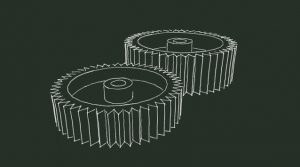
Before the transport container had been introduced, a normal transatlantic cargo ship might comprise 200,000 distinct items, comprising many hundreds of different shipments, from meals to letters to heavy machines. Hauling and loading this cornucopia in the dockside, then packaging it into the tightest corners of the hull, demanded ability, strength and bravery in the longshoremen, who would operate on one boat for days at a time. The container transport system changed all that. Loading and unloading a container ship is a gigantic ballet of steel slab cranes, choreographed by the computers which maintain the vessel balanced and monitor every container through a worldwide logistical system. Nevertheless, the basic technology that underpins it all could hardly be easier.
The shipping container is a 1950s innovation using 1850s know-how. As it was cheap, it worked. The container was a simple enough concept, and the man who masterminded its rise, Malcom McLean, could barely be described as an inventor. He was an entrepreneur who dreamed big, took daring risks, pinched pennies and deftly negotiated with authorities, port authorities and the unions. McLean’s real accomplishment was in changing the system that encompassed his box: how ships, trucks and vents were designed. It takes a visionary to see how toilet-paper creations can completely reshape systems; it is easier for our limited imaginations to slot Rachael-like creations into existing systems. If nuclear fusion functions, it simplifies gas, coal and nuclear fission within our comfortable conception of the grid: suppliers make power, and promote it to us. Solar batteries and power are a lot more challenging. They are quietly turning power businesses into something closer to Uber or Airbnb – a stage linking countless small providers and consumers of power, constantly balancing supply and demand.
Many technologies are truly revolutionary. They transcend the easy pragmatism of newspaper and CLT/laminated timber frames or barbed wire to make effects that would have seemed miraculous to earlier generations. But they take the time to reshape the financial systems around us longer than you might expect. No discovery matches that description more efficiently than power, hardly comprehended at the start of the 19th century but exploited and commodified by its ending.
 Usable light bulbs had emerged in the late 1870s, courtesy of Thomas Edison and Joseph Swan. In 1881, Edison constructed electricity-generating channels in New York and London and he started selling power as a commodity in a year. The first electric motors were used to drive manufacturing machinery annually after that. Yet the history of power in manufacturing poses a mystery. Poised to take off in the late 1800s, power flopped as a source of mechanical power with almost no effect whatsoever on 19th-century manufacturing. By 1900, electric motors were providing less than 5 percent of mechanical drive power in American factories. Despite the best efforts of Edison, Nikola Tesla and George Westinghouse, production was in the era of steam. Productivity finally jumped in US manufacturing only from the 1920s. The reason behind the 30-year delay? The new electric motors only worked well when everything else changed also.
Usable light bulbs had emerged in the late 1870s, courtesy of Thomas Edison and Joseph Swan. In 1881, Edison constructed electricity-generating channels in New York and London and he started selling power as a commodity in a year. The first electric motors were used to drive manufacturing machinery annually after that. Yet the history of power in manufacturing poses a mystery. Poised to take off in the late 1800s, power flopped as a source of mechanical power with almost no effect whatsoever on 19th-century manufacturing. By 1900, electric motors were providing less than 5 percent of mechanical drive power in American factories. Despite the best efforts of Edison, Nikola Tesla and George Westinghouse, production was in the era of steam. Productivity finally jumped in US manufacturing only from the 1920s. The reason behind the 30-year delay? The new electric motors only worked well when everything else changed also.
Steam-powered factories had delivered electricity through awe-inspiring driveshafts, secondary shafts, belts, belt towers, and tens of thousands of drip-oilers. The early attempts to introduce power only replaced the single huge engine with a similarly large electric motor. Results were disappointing. As the economic historian Paul David has contended, power succeeded only when factories themselves were reconfigured. The driveshafts were replaced by cables, the enormous steam engine by dozens of little motors. Factories distribute, there was natural light. Stripped of the driveshafts, the ceilings can be used to encourage pulleys and bubble cranes for hire. Employees had responsibility for their own machines; they had better training and better pay. The electric motor was a superb invention, once we shifted all of the everyday details that surrounded it.
David suggested in 1990 that what was true of electrical motors combined with eco-friendly tactics of engineered timber products may also prove true of computers: that we’d yet to see the full financial benefits because we had to work out how to reshape our economy to take advantage of them. Later research by economists Erik Brynjolfsson and Lorin Hitt backed the idea: they found that firms that had spent computers in the 1990s had seen few benefits, but those who had reorganised – decentralising, outsourcing and customising their products – had seen productivity soar. Overall, the productivity figures have yet to display anything like a 1920s breakthrough. In that respect we’re still waiting for David’s proposal to bear fruit. But in other ways, he had been proved right almost immediately. People were beginning to work out new ways to use computers and, in August 1991, Tim Berners-Lee posted his code to the net online so that others could download it and begin to tinker. It was another economical and unassuming technology, and it unlocked the potential of the older and grander net itself.
